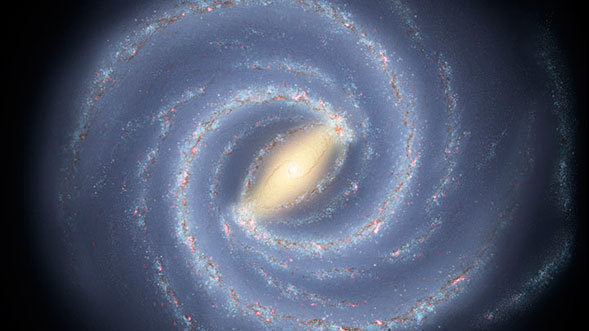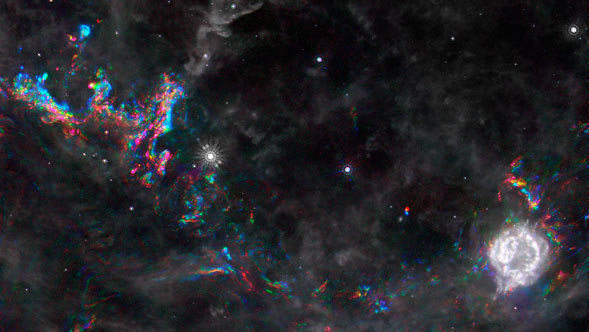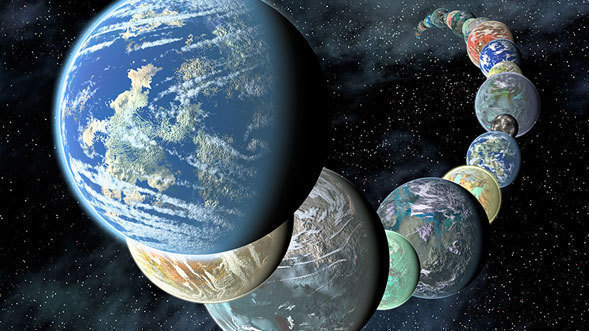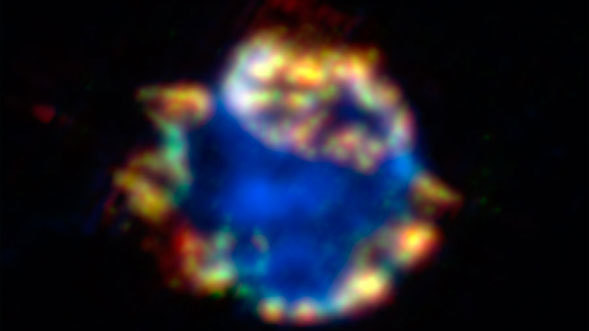Displaying news 361 - 390 of 587 in total
New images from NASA's Spitzer Space Telescope are shedding light on the true structure of the Milky Way, revealing that it has just two major arms of stars instead of the four it was previously thought to possess.
Astronomers have unearthed secrets from the grave of a star that blasted apart in a supernova explosion long ago. By decoding ghostly echoes of light traveling away from the remains of a supernova called Cassiopeia A, the scientists have pieced together what the star looked like in life, and ultimately how it met its demise.
NASA's Spitzer Space Telescope has found a bizarre ring of material around the magnetic remains of a star that blasted to smithereens.
On Earth, neon is known for being flashy. Any Las Vegas tourist knows that signs sporting this noble gas are hard to miss, but in space this is not always true. Neon is the fifth most abundant element in the cosmos, but until recently, astronomers couldn't seem to get a precise measurement of it in the Universe.
The incredible images from NASA's "Great Observatories" and many other NASA space- and ground-based telescopes are now available to the public in an educational and innovative manner through the release of the free WorldWide Telescope software from Microsoft.
When it comes to giving birth, galaxies don't seem to have a "ticking biological clock." In fact, observations from NASA's Spitzer Space Telescope show that old galaxies were the biggest producers of new stars when our universe was half of its current age of 13.6 billion years.
Millions of clustered stars glisten like an iridescent opal in a new image from NASA's Spitzer Space Telescope.
The universe's first "galactic cities" did not sprout up randomly across space. On the contrary, a new statistical analysis of observations from NASA's Spitzer Space Telescope confirms that these ancient galactic metropolises may have developed much like sprawling cities joining together into a larger urban whole.
Millions of faint galaxies are hovering near the edge of our universe, too dim to be detected by most telescopes -- but some huge cosmic explosions and the supersensitive infrared eyes of NASA's Spitzer Space Telescope are bringing many of these muted galaxies to light.
Researchers using NASA's Spitzer Space Telescope have discovered large amounts of simple organic gases and water vapor in a possible planet-forming region around an infant star, along with evidence that these molecules were created there. They've also found water in the same zone around two other young stars.
Diamonds may be rare on Earth, but surprisingly common in space -- and the super-sensitive infrared eyes of NASA's Spitzer Space Telescope are perfect for scouting them, say scientists at the NASA Ames Research Center in Moffett Field, Calif.
Astronomers have discovered that terrestrial planets might form around many, if not most, of the nearby sun-like stars in our galaxy. These new results suggest that worlds with potential for life might be more common than we thought.
NASA's Hubble and Spitzer space telescopes, with a boost from a natural "zoom lens," have uncovered what may be one of the youngest and brightest galaxies ever seen in the middle of the cosmic "dark ages," just 700 million years after the beginning of our universe.
Newborn stars peek out from beneath their natal blanket of dust in this dynamic image of the Rho Ophiuchi dark cloud from NASA's Spitzer Space Telescope.
New observations from NASA's Spitzer Space Telescope suggest that galaxies prefer to raise stars in cosmic suburbia rather than in "big cities."
At a ceremony held today at the National Federation of the Blind, NASA unveiled a new book that brings majestic images taken by its Great Observatories to the fingertips of the blind.
Space Telescope Science Institute
NASA's Spitzer Space Telescope has detected plump black holes where least expected -- skinny galaxies.
The University of Texas at Austin, McDonald Observatory
National Optical Astronomy Observatory
It's official -- "The Hidden Universe" is no longer a secret. The video podcast series from NASA's Spitzer Space Telescope Science Center has reached one million downloads!
Astronomers have at last found definitive evidence that the universe's first dust -- the celestial stuff that seeded future generations of stars and planets -- was forged in the explosions of massive stars.
Billions of years ago, small galaxies across the universe regularly collided -- forcing the gas, dust, stars, and black holes within them to unite. The clashing of galactic gases was so powerful it ignited star formation, while fusing central black holes developed an insatiable appetite for gas and dust.
M51, whose name comes from being the 51st entry in Charles Messier's catalog, is considered to be one of the classic examples of a spiral galaxy. At a distance of about 30 million light years from Earth, it is also one of the brightest spirals in the night sky. A composite image of M51, also known as the Whirlpool Galaxy, shows the majesty of its structure in a dramatic new way through several of NASA's orbiting observatories. X-ray data from NASA's Chandra X-ray Observatory reveals point-like sources (purple) that are black holes and neutron stars in binary star systems. Chandra also detects a diffuse glow of hot gas that permeates the space between the stars. Optical data from the Hubble Space Telescope (green) and infrared emission from the Spitzer Space Telescope (red) both highlight long lanes in the spiral arms that consist of stars and gas laced with dust. A view of M51 with the GALEX telescope shows hot, young stars that produce lots of ultraviolet energy (blue).
A developing star wrapped in a black cocoon of dust is seen sprouting giant jets in a new image from NASA's Spitzer Space Telescope.
A stellar prodigy has been spotted about 450 light-years away in a system called UX Tau A by NASA's Spitzer Space Telescope. Astronomers suspect this system's central Sun-like star, which is just one million years old, may already be surrounded by young planets. Scientists hope the finding will provide insight into when planets began to form in our own solar system.
University of Michigan
The next time you take a moonlit stroll, or admire a full, bright-white moon looming in the night sky, you might count yourself lucky. New observations from NASA's Spitzer Space Telescope suggest that moons like Earth's -- that formed out of tremendous collisions -- are uncommon in the universe, arising at most in only 5 to 10 percent of planetary systems.
Displaying news 361 - 390 of 587 in total




























